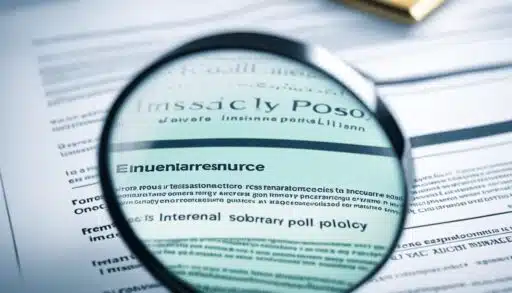Convertible term life insurance is a type of insurance policy that provides the flexibility to convert to a permanent policy. This means that you have the option to change your coverage before the end of the term. It offers the benefits of both term life insurance and permanent life insurance, providing you with financial security and peace of mind.
With convertible term life insurance, you start with a term policy, which provides coverage for a specific period of time. During this term, you have the option to convert your policy to a permanent one, such as whole life insurance. This allows you to continue your life insurance coverage beyond the initial term without the need to reapply or undergo a medical exam.
Key Takeaways:
- Convertible term life insurance offers the flexibility to convert to a permanent policy.
- You can change your coverage before the end of the term without the need to reapply or undergo a medical exam.
- It provides the benefits of both term life insurance and permanent life insurance.
- Converting to a permanent policy offers continued coverage and financial security.
- Convertible term life insurance is a good option for individuals who anticipate changes in their life insurance needs.
What is Convertible Term Life Insurance?
Convertible term life insurance is a type of life insurance that offers the policyholder the option to convert their term policy into a permanent policy. With term life insurance, the coverage is in effect for a specific period, usually 10, 20, or 30 years. However, if the policyholder decides they need coverage beyond the term or want to switch to permanent coverage, they can convert their term policy.
One of the advantages of convertible term life insurance is that the conversion process typically does not require a medical exam or an additional application. This can be beneficial for individuals who may have developed health conditions since the start of their term policy or who want to secure permanent coverage without going through the underwriting process again.
It’s important to note that the conversion option may expire after a certain age or at the end of the term, depending on the policy and the insurance company. Therefore, it’s crucial to understand the specific terms and conversion rules of the convertible term life insurance policy you’re considering.
“Convertible term life insurance provides the flexibility to convert a term policy into permanent coverage without the need for a medical exam or additional application, offering peace of mind for individuals who want to ensure long-term protection.”
Table: Comparison of Term Life Insurance and Convertible Term Life Insurance
| Feature | Term Life Insurance | Convertible Term Life Insurance |
|---|---|---|
| Coverage Duration | Fixed term (e.g., 10, 20, or 30 years) | Convertible to permanent coverage |
| Medical Exam | May require a medical exam | Conversion typically does not require a medical exam |
| Application | May require a new application | Conversion does not require an additional application |
| Cost | Typically less expensive | Premiums for permanent coverage may be higher |
In summary, convertible term life insurance provides the flexibility to convert a term policy into a permanent policy without the need for a medical exam or additional application. This option allows individuals to secure long-term protection and peace of mind, even if their circumstances or health change during the term of the policy. Understanding the specific terms, conversion rules, and age restrictions of the convertible term life insurance policy is essential when considering this type of coverage.
Benefits of Convertible Term Life Insurance
Convertible term life insurance offers numerous benefits to policyholders, providing valuable advantages when compared to traditional term life insurance policies. The ability to convert to permanent coverage without the need to reapply or undergo a medical exam is one of the main benefits of this type of insurance. This means that if you still need life insurance coverage after your term policy expires, you can seamlessly convert it to a permanent policy.
Another significant benefit of convertible term life insurance is that the death benefit remains in place when converting. This ensures that your loved ones will receive the full coverage amount in the event of your passing, regardless of whether you have converted your policy or not. This can provide peace of mind and financial security for your family, knowing that they will be protected even after the initial term ends.
Additionally, convertible term life insurance offers flexibility in terms of adapting to changes in your life insurance needs. It allows you to adjust your coverage before the end of the term, providing the opportunity to increase or decrease your coverage amount based on your current circumstances. This flexibility can be particularly beneficial if your financial situation or personal obligations change over time.
Table: Benefits of Convertible Term Life Insurance
| Benefits | Description |
|---|---|
| Flexibility | Ability to change coverage before the end of the term |
| No reapplication or medical exam | Convert to permanent coverage without additional requirements |
| Death benefit remains | Full coverage amount paid to beneficiaries |
| Adaptable coverage | Adjust coverage based on changing needs |
Overall, convertible term life insurance provides policyholders with the flexibility, convenience, and peace of mind necessary to navigate the evolving landscape of life insurance. It is a suitable option for individuals who anticipate changes in their life insurance needs and want the freedom to convert to permanent coverage when the time is right.

How Does Convertible Life Insurance Work?
Convertible life insurance offers policyholders the opportunity to convert their term policy to a permanent policy. This can be done within a specific conversion period, which varies by insurance company. During the conversion period, policyholders have the flexibility to change their coverage and enjoy the benefits of permanent life insurance.
Each insurance company has its own rules and requirements for policy conversion. The conversion period is the timeframe during which policyholders can convert their term policy to a permanent policy without the need for a medical exam or additional application. It is important for policyholders to be aware of the conversion period specified in their policy to take advantage of this option.
The available policies for conversion also vary by insurer. Some companies offer a range of permanent policy options, allowing policyholders to choose the coverage that best suits their needs. Additionally, some insurers may allow partial conversions, where policyholders have the option to convert only a portion of their term policy to permanent coverage.
| Insurance Company | Conversion Period | Available Policies for Conversion | Partial Conversions Allowed |
|---|---|---|---|
| Company A | Up to age 65 | Whole Life, Universal Life | No |
| Company B | Within first 10 years of the term | Universal Life | Yes |
| Company C | Within first 5 years of the term | Whole Life | Yes |
Policyholders should consult with their insurance company to understand the specific conversion options available to them and any associated costs or changes in premiums. Understanding how convertible life insurance works can help policyholders make informed decisions about their coverage and ensure they have the financial security they need for the future.
Reasons to Consider Convertible Term Life Insurance
Convertible term life insurance offers several compelling reasons to consider it as a viable option for your life insurance needs. By understanding the benefits and flexibility it provides, you can make an informed decision that suits your specific circumstances.
Financial Support for Dependents
If people still rely on your income at the end of your term, converting your term life insurance policy can provide continued financial support. Converting to a permanent policy ensures that your loved ones will receive a death benefit even after the initial term expires. This can provide peace of mind and ensure financial security for your dependents when they need it most.
Protection from Additional Debts
If you have taken on additional debts that won’t be paid off by the end of your term, converting your policy can protect your family from shouldering that burden. By converting to a permanent policy, you maintain life insurance coverage beyond the initial term, ensuring that any outstanding debts will be covered. This can prevent your loved ones from facing financial hardship in the event of your passing.
Adapting to Changed Health Conditions
If your health has changed since you initially purchased your term life insurance policy, you may not qualify for a new policy. Converting your existing policy to a permanent one allows you to lock in coverage and rates based on your health at the time of conversion. This can be particularly beneficial if your health condition has deteriorated, as it ensures continued coverage without the need for a medical exam or reapplication.
Also Read:- Secure Your Future With Midland National Life Insurance
Overall, convertible term life insurance offers the flexibility to adapt to changing circumstances and provides financial security for your loved ones. By considering the benefits of conversion, you can make an informed decision that aligns with your long-term life insurance needs.

Partial Conversions in Convertible Term Life Insurance
Convertible term life insurance offers the unique option of partial conversions, allowing policyholders to convert only a portion of their policy to permanent coverage. This flexibility can be advantageous for individuals who may not require full permanent coverage but still want to secure some level of long-term protection.
When considering a partial conversion, it’s important to note that insurance companies typically have a minimum amount that can be converted. This means that there may be a threshold you need to meet in order to take advantage of this option. Additionally, it’s worth mentioning that the premiums for the converted portion of the policy may be higher than those for the remaining term coverage.
While partial conversions can be a valuable tool for tailoring your life insurance coverage to your specific needs, it’s essential to carefully evaluate your financial situation and future requirements before making any decisions. Consulting with a knowledgeable insurance professional can help you navigate the complexities of partial conversions and determine the most suitable course of action.

Example of Partial Conversion Options:
| Policy Term | Policy Amount | Partial Conversion Options | Converted Amount | Premiums for Converted Portion |
|---|---|---|---|---|
| 20 years | $500,000 | Convert 50% | $250,000 | Higher than remaining term coverage |
| 30 years | $1,000,000 | Convert 25% | $250,000 | Higher than remaining term coverage |
| 15 years | $750,000 | Convert 75% | $562,500 | Higher than remaining term coverage |
How to Convert Your Life Insurance Policy
Converting your life insurance policy is a straightforward process that requires a few key steps. Before making any decisions, it’s important to first confirm with your insurance company that you have a convertible term life insurance policy and that you are within the conversion period. Once you have this confirmation, you can proceed with the conversion process.
The first step in converting your life insurance policy is to determine the amount of coverage you need for the conversion. Consider factors such as your current financial obligations, your future financial goals, and any changes in your circumstances since you first purchased the policy.
After you have determined the coverage needed, you will need to fill out the necessary conversion forms with your insurer. These forms will outline the details of the conversion, including the type of policy you wish to convert to and any additional requirements or documentation needed.
Table: Steps to Convert Your Life Insurance Policy
| Step | Description |
|---|---|
| Step 1 | Confirm with your insurance company that you have a convertible term life insurance policy and are within the conversion period. |
| Step 2 | Determine the amount of coverage needed for the conversion based on your financial obligations and goals. |
| Step 3 | Fill out the necessary conversion forms provided by your insurer. |
| Step 4 | Submit the completed conversion forms to your insurance company for processing. |
| Step 5 | Review the terms and conditions of the new policy and make any necessary adjustments before finalizing the conversion. |
| Step 6 | Make any required premium payments for the new policy to ensure continuous coverage. |
Once you have submitted the completed conversion forms, your insurance company will review the application and process the conversion. It is important to review the terms and conditions of the new policy and make any necessary adjustments before finalizing the conversion. Additionally, ensure that you make any required premium payments for the new policy to ensure continuous coverage.
Costs of Converting a Policy
When considering convertible term life insurance, it’s important to understand the costs associated with converting a policy. While the conversion process itself does not have any associated fees, the premiums for the new permanent policy will be higher than those for the term policy. The cost of the new premiums will depend on your age at the time of conversion.
Converting a policy allows you to maintain coverage beyond the term of your initial policy, providing continued financial security for you and your loved ones. However, it’s important to consider the potential increase in premiums when making the decision to convert. The cost to convert a policy can vary based on factors such as your age, health, and the coverage amount you choose for the new permanent policy.
It’s recommended to consult with your insurance provider to understand the specific costs associated with converting your policy. They can provide you with a detailed breakdown of the new premium amounts and help you assess the financial impact of the conversion. By carefully considering the costs and benefits, you can make an informed decision about whether converting your convertible term life insurance policy is the right choice for your long-term financial planning.

| Age at Conversion | New Premiums |
|---|---|
| 35 | $150/month |
| 40 | $200/month |
| 45 | $250/month |
“Converting your term life insurance policy to a permanent policy can offer valuable benefits, but it’s important to carefully consider the costs involved. Understanding the potential increase in premiums based on your age can help you make an informed decision.”
Alternatives to Life Insurance Conversion
If you find yourself in a situation where converting your term life insurance policy is not the right option for you, there are alternatives to consider. These alternatives can help you maintain coverage without the need for conversion.
Renew Existing Term Policy: If your term policy is coming to an end but you still need coverage, you can choose to renew your existing policy on an annual basis. This allows you to continue with your current coverage without the need for conversion or applying for a new policy.
Purchase a New Term Policy: Another alternative is to purchase a new term life insurance policy. This can be beneficial if your needs have changed since you initially purchased your current policy. You can select a new term length that aligns with your current situation and provides the coverage you require.
Life Insurance Ladder Strategy: The life insurance ladder strategy involves stacking multiple term life insurance policies that expire at different times. By doing so, you can ensure that you have coverage for specific time periods and eliminate the need for conversion. This strategy allows you to tailor your coverage to different stages of your life and financial obligations.
Consider these alternatives to life insurance conversion to find the best option for your needs and financial situation. Whether you choose to renew your existing policy, purchase a new term policy, or implement the life insurance ladder strategy, maintaining coverage is essential for your peace of mind and financial security.
Summary:
When convertible term life insurance doesn’t align with your current needs or financial situation, there are alternative options to consider. Renewing your existing term policy on an annual basis allows you to maintain coverage without the need for conversion. Purchasing a new term policy can provide you with the flexibility to tailor your coverage to your current circumstances. The life insurance ladder strategy involves stacking multiple term policies, ensuring coverage for specific time periods and eliminating the need for conversion. Exploring these alternatives can help you find the most suitable solution for your life insurance needs.
Cash Value in Convertible Term Life Insurance
Convertible term life insurance is a valuable option for those seeking flexibility in their life insurance coverage. While it does not have a cash value component on its own, converting to a permanent policy opens up the opportunity to accumulate cash value over time. This can provide additional financial security and options for policyholders.
By converting your term policy to a permanent one, you can begin to build cash value through the payment of premiums. The cash value grows over time and can be accessed through loans or withdrawals if needed. This can be particularly useful for individuals who may require extra funds in the future for various reasons, such as unexpected medical expenses, education costs, or supplementing retirement income.
Convertible term life insurance allows policyholders to adapt their coverage to meet changing needs, and the potential for cash value accumulation adds an extra layer of financial flexibility.
It’s important to note that the cash value component in a permanent policy is separate from the death benefit. While the death benefit provides a payout to beneficiaries upon the policyholder’s passing, the cash value represents the equity accrued within the policy. It can serve as a valuable asset that policyholders can access while they are still alive.
| Benefits of Cash Value in Convertible Term Life Insurance |
|---|
| Financial Flexibility: The cash value can be used to supplement income, cover unexpected expenses, or provide a source of funds in times of need. |
| Asset Growth: As the cash value accumulates, it has the potential to grow over time, providing policyholders with an additional financial resource. |
| Loan and Withdrawal Options: Policyholders can access the cash value through loans or withdrawals, providing a source of liquidity when needed. |
Overall, the potential for cash value accumulation in convertible term life insurance adds an extra layer of financial security and flexibility. It’s important to discuss this option with your insurance provider to fully understand the benefits and considerations before making a decision.
Difference Between Convertible and Renewable Term Life Insurance
When considering life insurance options, it’s important to understand the differences between convertible term life insurance and renewable term life insurance. While both provide temporary coverage for a specific term, there are distinct features that set them apart.
Convertible Term Life Insurance
Convertible term life insurance offers the policyholder the flexibility to convert their policy into a permanent one. This means that before the term ends or within a specified timeframe, you have the option to switch to permanent coverage without undergoing additional medical exams or applications. Convertible term life insurance allows you to adapt your coverage as your needs change, providing financial security for the long term.
Renewable Term Life Insurance
Renewable term life insurance, on the other hand, allows you to renew your policy for another term after the initial term expires. This can be advantageous if you anticipate your coverage needs to extend beyond the original term. However, it’s important to note that when renewing a term policy, the premiums are likely to increase as you get older. Renewable term life insurance provides temporary coverage but does not offer the option to convert to permanent coverage.
| Convertible Term Life Insurance | Renewable Term Life Insurance |
|---|---|
| Allows conversion to permanent coverage | Allows renewal for another term |
| No additional medical exams or applications required for conversion | Premiums may increase at each renewal |
| Provides long-term financial security | Offers temporary coverage |
Understanding the difference between convertible and renewable term life insurance is crucial when selecting the right policy for your needs. Consider your long-term goals and financial security when deciding which option is best for you.

Conclusion
Convertible term life insurance offers numerous benefits and provides individuals with the flexibility to adapt their coverage to their changing needs. By choosing a convertible term policy, you have the option to convert to permanent coverage in the future, ensuring long-term financial security for you and your loved ones.
One of the key advantages of convertible insurance is its flexibility. It allows you to adjust your coverage without the need for additional medical exams or applications. This means that if your circumstances change, such as having dependents who still rely on your income or acquiring additional debts, you can convert your policy to provide continued protection.
Furthermore, convertible term life insurance offers the opportunity to build cash value over time. As you convert to a permanent policy, you can accumulate cash value that can be utilized for loans or withdrawals if needed, providing an additional financial resource.
In summary, convertible term life insurance offers the benefits of flexibility and financial security. It allows you to adapt your coverage as your needs evolve and ensures that you have the necessary protection in place to safeguard your loved ones. Consider the advantages of convertible insurance when choosing a policy that meets your long-term goals.
FAQs
Q: What is convertible term life insurance?
A: Convertible term life insurance is a type of term life insurance that can be converted into a permanent policy.
Q: How does convertible term life insurance work?
A: Convertible term life insurance allows policyholders to convert their term policy to a permanent policy before the term ends or before a certain age.
Q: What are the benefits of convertible term life insurance?
A: The main benefit is the ability to convert to permanent coverage without the need for a medical exam or additional application.
Q: How do I convert my life insurance policy?
A: You need to confirm with your insurance company that you have a convertible term life insurance policy, determine the coverage needed for conversion, and fill out the necessary conversion forms.
Q: Is there a cost to convert a policy?
A: The conversion process itself does not cost anything, but the premiums for the new permanent policy will be higher than for the term policy.
Q: Are there alternatives to life insurance conversion?
A: Yes, you can renew your existing term policy, purchase a new term policy, or use the life insurance ladder strategy.
Q: Does convertible term life insurance have a cash value component?
A: Convertible term life insurance itself does not have a cash value component, but if you convert to a permanent policy, you can accumulate cash value.
Q: What is the difference between convertible and renewable term life insurance?
A: Convertible term life insurance allows for conversion to permanent coverage, while renewable term life insurance allows for renewal of the policy for another term.
Q: What is convertible term life insurance?
A: Convertible term life insurance is a type of policy that allows the policyholder to convert their term life insurance policy into a permanent life insurance policy without having to undergo a medical exam.
Q: How does convertible term life insurance work?
A: Convertible term life insurance works by providing coverage for a specified term, typically 10, 20, or 30 years. During the conversion period, the policyholder has the option to convert the policy to a permanent coverage without the need for a medical exam.
Q: What are the advantages of convertible term life insurance?
A: The advantages of convertible term life insurance include the flexibility to convert to a permanent policy, even if the policyholder’s health has deteriorated, and the option to secure lifelong coverage without requalifying for insurance.
Q: Can I convert a term policy to permanent coverage?
A: Yes, convertible term life insurance allows you to convert a term policy to permanent coverage, such as whole life insurance, without proving insurability or undergoing a medical exam.
Q: What is the difference between term insurance and permanent insurance?
A: Term insurance provides coverage for a specified period, while permanent insurance, such as whole life insurance, lasts the policyholder’s entire life and includes a cash value component.
Q: When should I consider converting my term policy to permanent coverage?
A: You should consider converting your term policy to permanent coverage if you want lifelong coverage, need the option to access cash value, or your insurance needs change as you get older.
Q: Do I need to take a medical exam to convert from term to permanent coverage?
A: No, with convertible term life insurance, you can convert to permanent coverage without having to take a medical exam or prove insurability.
Q: Is convertible term life insurance more expensive than term insurance?
A: Yes, convertible term life insurance may be more expensive than traditional term insurance due to the added flexibility and the option to convert to permanent coverage without requalifying for insurance.
Q: Can I convert a term life insurance policy after the initial term has ended?
A: Yes, convertible term life insurance allows you to convert to a permanent policy even after the initial term has ended, providing you the opportunity to secure permanent coverage.
Q: How does the conversion process from term to permanent life insurance work?
A: The conversion process from term to permanent life insurance involves notifying the insurance company of your intent to convert, selecting the permanent policy, and adjusting the premiums based on the new coverage.




